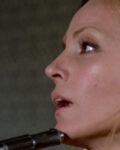CD: Krull (1983)
Return to: Home / Soundtrack Reviews / J to L
.
Label: La-La Land Records// Released: July, 2010
Tracks & Album Length: CD1: 11 tracks / (45:23) + CD2: 12 tracs / (54:16)
.
Special Notes: 16-page colour booklet with liner notes by Jeff Bond / Limited to 3000 copies.
.
Composer: James Horner
.
.
Review:
One of the reasons James Horner was able to rise up from the exploitation world of Roger Corman and quickly land plum A-list films was his adeptness with large-scale orchestral writing. His sound was unique: brassy, yet elegant; romantic, but modernistic in the way beautiful themes quickly morphed into gnashing chaos; and commercial in the sense that his music was, much like John Williams, accessible to the masses.
Horner’s gifts include an ability to score any genre using any kind of traditional or fusion sounds (Red Heat being a prime example of orchestral / rock / pop-jazz / and modernism) but with Krull he stuck with the traditional symphonic sound befitting an epic. Coming off Star Trek II: The Wrath of Khan (1982), Horner went a little further in designing a score with a wider sonic dimension, and it’s the purity of this approach which has made Krull popular among his fans.
Although released and reissued several times – the original Southern Cross CD and gold discs featured more music than the LP; the Super Tracks 2-disc set further augmented the score’s running time – La-La Land’s CD features the complete score plus a few bonus cues that finally present Krull as a large symphonic tone poem, replete with character themes, romantic passages, and action music where Horner pays direct homage to Korngold and Wagner. The remastering also brings out many of Horner’s intricate details which still impress because the score often feels like a subtle battle between Horner’s classical training and his desire to go deeper into avant garde sounds; he wants to be abrasive and aggressive, yet there’s a compulsion to put each diverging sound in its proper place, saving it for a discrete effect rather than stopping the score’s flow cold for a suite of cacophony.
That inner battle makes Krull rather attractive, but as fans adore every nuance of the composer’s style, detractors will also find plenty of examples where Krull is endemic of his re-using themes and motifs from other scores. Krull, however, doesn’t feel like a pastiche, but it is the product of a busy composer who in 1983 scored 7 feature films – one of the busiest periods of his career. What ultimately transpired from Horner’s pen is a peculiar blend of homages to classic Hollywood action scores, Romantic classical music, and ideas stemming from prior works as well as early formations of motifs he’d use in subsequent films.
“The Slayers Attack” has vestiges of Star Trek II (both in its Romantic theme and Kilingon ‘war cry’), Wolfen (the snarling and twirling brass which accompany wolf attacks), and Brainstorm, scored the same year as Krull. The appearance of this material makes Krull a bit frustrating, but it’s less distracting than expected, and it’s impossible not to admire the richness of the score’s instrumentation. While the film may have been a box office dud, Horner was able to parlay the success of his score and work on further films, but ironically outside of Star Trek III: The Search for Spock (1984), Aliens (1986), and Willow (1988), most of his assignments over the next 10 years would be a mix of comedies, dramas, and action scores requiring more contemporary sounds, and fusions with rock and electronica..
.
© 2012 Mark R. Hasan
.
External References:
IMDB — Soundtrack Album — Composer Filmography
.
Return to: Home / Soundtrack Reviews / J to L
Category: Soundtrack Reviews


















Connect